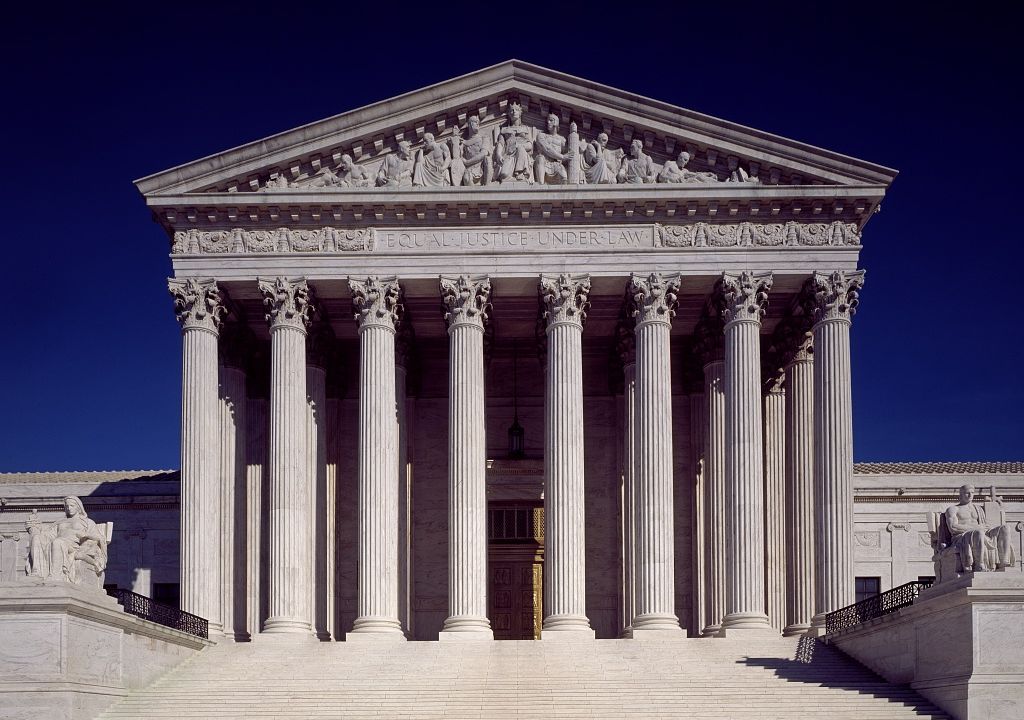
A view of the Supreme Court Building, with "Equal Justice Under the Law" inscribed on its pediment. (Photo by Carol Highsmith, 1980, Library of Congress)
It’s not the kind of birthday present anyone was looking for — just two days after the Voting Rights Act of 1965 celebrated its 52nd birthday the Justice Department filed an amicus brief in a Supreme Court case that supports Ohio’s draconian voter purges. Ohio’s law allows the state to eliminate from voter rolls any registered voter who has not shown any “voting activity” in the last six years. The plaintiff, Larry Harmon, backed by the American Civil Liberties Union of Ohio and the think tank Demos, filed suit when he was found he was removed from the voting rolls for not attending the polls from 2008 to 2015. Ohio has purged more voters from its rolls than any other state — 2 million voters from 2011 to 2016, including 1.2 million for infrequent voting. An analysis from Reuters found that voters in Democratic-leaning areas were nearly twice as likely to be removed as those in Republican-leaning ones. The filing of the amicus brief is a direct reversal of the Obama administration’s position on the case.
Ari Berman tells the full story at Mother Jones.
The brief is not the administration’s first action that could lead to voter purges. On June 28, the same day President Donald Trump’s election integrity commission asked for sweeping voter data from all 50 states, the Justice Department sent a letter to 44 states, informing them that it was reviewing their voter list maintenance procedures and asking them how they planned to “remove the names of ineligible voters.” Vanita Gupta, the head of the department’s Civil Rights Division under President Barack Obama, called the letter “virtually unprecedented” and “a prelude to voter purging.”
In the Ohio case, a federal appeals court ruled in September that the state had violated the National Voter Registration Act, a 1993 law that made it easier to register at the DMV and other public agencies and stipulated that voter-roll maintenance “shall not result in the removal of the name of any person from the official list of voters registered to vote in an election for Federal office by reason of the person’s failure to vote.” As a result of that ruling, 7,500 people who would have otherwise been purged were able to vote in the 2016 election, including Harmon.
The Obama administration backed that position, but the Trump administration has now reversed course. “After this court’s grant of review and the change in administrations, the department reconsidered the question,” says the Justice Department’s new brief. “It has now concluded that the NVRA does not prohibit a state from using nonvoting as the basis for sending a [removal] notice.” Notably, no career lawyers from the Civil Rights Division signed the brief, as is customary, potentially signifying internal opposition to the department’s new position. (The same thing happened with the Justice Department’s recent opposition to affirmative action on college campuses.)
Of course the issue of voter rights has had a long slide in recent years, due in part to a 2013 Supreme Court decision Shelby County v. Holder, which struck down Section 4(b) of the Voting Rights Act, and according to many, hollowed out one the main purposes of the 1965 legislation. Section 4(b) was the mechanism behind Section (5) which required that states with a history of voting discrimination have any change to voting qualifications, practices or procedures, pre-approved by the Justice Department.
Since that ruling a bevy of states, many of them which would have been covered under Section (5), have instituted stricter voter identification laws and instituted voter roll purges. Here are just a few examples also from Ari Berman from his round-up of the 2016 election — the first election without full protection of the Voting Rights Act:
- Fourteen states had new voting restrictions in place for the first time in 2016.
- There were 868 fewer polling places in states with a long history of voting discrimination, like Arizona, Texas and North Carolina.
- In Wisconsin, where 300,000 registered voters, according to a federal court, lacked strict forms of voter ID, voter turnout in Wisconsin was at its lowest levels in 20 years and decreased 13 percent in Milwaukee, where 70 percent of the state’s African-American population lives.
- In North Carolina, black turnout decreased 16 percent during the first week of early voting because “in 40 heavily black counties, there were 158 fewer early polling places.”
But all is not lost. In May the Supreme Court rejected a case involving North Carolina’s strict voter-ID law. A lower court ruled that the law was an effort to “target African-Americans with almost surgical precision.” In addition a federal appeals court struck down a controversial Texas voter-ID law that had caused significant problems at the polls in 2016. The Supreme Court also declined to hear the Texas case.
Read more installments in our series “While He Was Tweeting” — keeping an eye on Trump’s wrecking ball.



